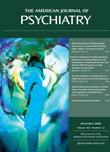Delusional Parasitosis Facilitated by Web-Based Dissemination
To the Editor: Many scholars have anticipated and foreseen the positive effect of the Internet on medicine. Pallen (1) noted that “[the] Internet promises to bring enormous future benefits to medicine….Perhaps more importantly, the Internet culture will infect and transform the culture of medicine.” However, one potential negative consequence is the dissemination of information with minimal or no supporting evidence that is incorrectly portrayed as factual. We report the case of an individual who experienced delusional ideation via the Internet.
“Mr. M” was a 57-year-old Caucasian man who presented at a detoxification center for crack cocaine dependence and schizophrenia marked by persistent auditory hallucinations and paranoid delusions. On assessment, the patient had patches of erythematous skin in his nose and on his right ear, forehead, and right leg. These erythematous patches had been present for 3 to 4 years. A dermatologist had diagnosed the lesions as a delusion of parasitosis. The patient strongly disagreed with this diagnosis and felt that the lesions were caused by a parasite. He stated that he had obtained information regarding his condition from the Internet and that the condition was called Morgellons. Our clinical team searched the Internet and found results under “Morgellons.”
In 2002, the Morgellons Research Foundation was founded as a personal initiative by a family who claimed that their 2-year-old son had a dermatological condition that many physicians were unable to diagnose. The Morgellons Research Foundation named the unknown condition “Morgellons disease” and launched a concerted effort to achieve recognition of “Morgellons” as a dermatological entity of infectious cause, creating a website complete with written descriptions and images of skin as well as microscopy images. Over the course of the years, thousands of people have visited the Morgellons Research Foundation website, and mass media coverage has amplified its diffusion (2) . Today, the website claims that more than 12,000 families affected by Morgellons are registered with the foundation, and self-accounts of affected individuals are overflowing (3) . Furthermore, the foundation—through its website—has lobbied the Center for Disease Control to fund an epidemiological study of the condition, which is an unprecedented endeavor (4) . The foundation’s efforts and claims are in contrast to the most common clinical perception of the illness, since current medical opinion considers the phenomenon to be delusional parasitosis (2) .
Aside from exemplifying that the Internet can be a misleading source of information, the situation we described demonstrates the challenge that some online communities represent to traditional diagnostic criteria, i.e., that a belief is not considered delusional if it is accepted by other members of an individual’s culture or subculture. Although this may be appropriate in the context of spiritual or religious beliefs, the scenario in which a widely held belief is accepted as plausible simply because many people ascribe to it requires a revised conceptualization in our current era. That is, Internet technology may facilitate the dissemination of bizarre beliefs on a much wider scale than ever before. In the case of Morgellons, the potential facilitation of factitious cases creates yet another troubling concern. An awareness of the capacity of the Internet to make possible and spread shared delusional ideation is essential to current practice.
1. Pallen MJ: Medicine and the Internet: dreams, nightmares and reality. Br J Hosp Med, 1996; 56:506–509Google Scholar
2. Accordino RE, Engler D, Ginsburg IH, Koo J: Morgellons disease? Dermatol Ther 2008; 21:8–12Google Scholar
3. Morgellons Research Foundation Website: http://www. morgellons. org/. Accessed August 2008Google Scholar
4. Marris E: Mysterious “Morgellons disease” prompts US investigation. Nat Med 2006; 12:982Google Scholar



